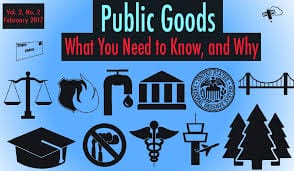
In Microeconomics 101, students are taught the concept of “Market Failures.” The “invisible hand’s” mechanism doesn’t always work, and in particular in case of “Public Goods,” “Externalities” (such as pollution deriving from a production activity) and “Natural Monopolies” (when start-up costs, barriers to entry, and significant economies of scale lead to only one firm being able to efficiently provide the service in a certain territory).
Public Goods are goods and services which are “non-excludable” (i.e. all consumers can consume the good) and non-rival (each consumer can consume all of the good). Typical examples include broadcast radio and TV programs, national defense and domestic security, public highways, and national parks. The key to public goods (which, by the way, can also be provided by private-sector entities, as in the case of radio and TV programs) is that it may be very hard to establish a price for their consumption and – as such – they may be offered for free; hence, their production needs to be financed by non-profit-maximising entities, typically the state.
Domestic services such as domestic security, national parks and public illumination, or international public goods such as national defense, international security and “a peaceful global environment”, are therefore more efficiently produced by the state, which is non-profit maximising organisation, and financed by taxes. This is what centuries of economic history has taught us.
When Elon Musk’s DOGE performs its indiscriminate cuts to public services, with the idea that any penny spent by the government is wasted, it seems to neglect the fact that the state provides essential services that nobody else would provide because it’s hard to price them and no profit-maximising private-sector institutions would do them instead.
Additionally, the state expenditure (symbolised by “G” in the national income GDP equation) provides an essential cushion to economic activity. When public spending was limited (such as in the 18th and 19th century) economic activity swung wildly, because it was simply following the cycle of private sector investment. But when uncertainty was too high, Keynes’ “preference for liquidity” kicked in, and investment froze, as there was not a level of interest rate low enough to convince entrepreneurs to invest. So, Keynes’ solution of promoting public investment was to provide a solution to such “liquidity trap.” Again, centuries of economic history has taught us that “Big Governments” stabilise economic cycles.
So far, this may be an excusable lack of knowledge or understanding of basic economic facts. It would be different if those indiscriminate expenditures cuts were only aimed at making the tax cuts promised to the well off become permanent via a cut to public spending. This is what a recent study by Yale University suggests: “The proposed GOP budget whose framework was supported last month in a vote by the House would include $4.5 trillion in tax cuts that would largely benefit the wealthy, along with $1.5 trillion in spending cuts, including to benefits for the public, including the poorest.” This would translate in a massive wealth transfer from the poorest 40% of the population to the wealthiest 1% of the population. “Stealing from the poor to the give to the rich”: kind of the opposite of what Robin Hood did.